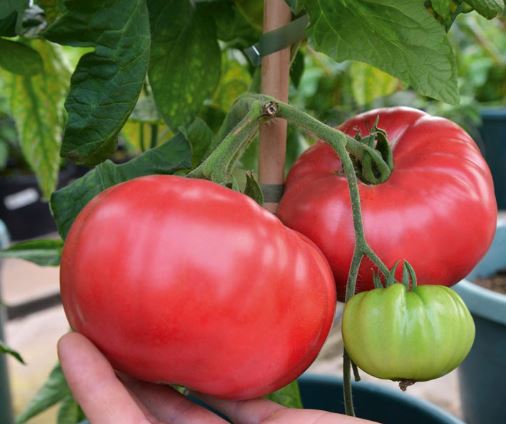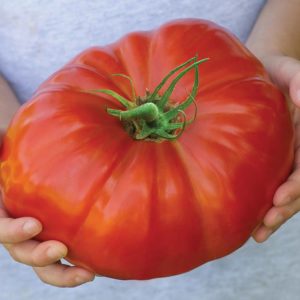Many gardeners who try to grow beefsteak tomatoes struggle to get a successful crop, especially if they’re growing in a short season area.
One reason is that larger tomatoes have more growing to do, so require better growing conditions than their smaller cousins.
Above, Crimson Crush beefsteak tomato available from Suttons Seeds.
Another reason is because we try to grow the large tomato varieties in the same way as we grow the cherry tomatoes. However, most beefsteak varieties require excellent growing conditions in order for the fruit to mature before the autumn weather stops growth.
Here are a few tips for growing the larger tomato.
- Choose vigorous varieties – most F1 Hybrids.
- Don’t go for the biggest variety available.
- An early maturing variety “days to maturity” is more likely to succeed than a late season one.
- Try early to set fruit or cold tolerant ones such as Oregon Spring.
- Beefsteaks will require bigger pots for their roots.
- They usually need a higher strength nutrient level – especially calcium and potassium.
- Large tomatoes are prone to blossom end rot so will require a good amount of calcium – using a foliar spray is good.
- Water supply is also an issue, if the plant does not have access to water (and food) when it needs it, blossom end rot and skin cracking is more likely.
- Good consistent temperatures are also needed but often out of the control of the average tomato gardener.
- Be realistic – don’t expect to grow eight whoppers on each truss!
- As soon as trusses begin to set, remove flowers to around three/four per truss.
- Using air pots allow more oxygen into the root zone and produce more energy.
There are new large varieties appearing in the seed catalogues each season, especially F1 Hybrids.
Take a look at Gigantomo from Thompson and Morgan for size – click photo for seeds!
Long and Short Season Areas
If you live in a part of the world with long warm summers, growing large varieties is definitely less challenging than if you live in an area which is frost free for only four to five months each season – such as the UK.

One variety that I have always had success with is Oregon Spring. This is a bush variety that was developed for cooler conditions, as its name suggests, and given good conditions should do well.
It’s not a whopper, but well above average salad tomato size and has a very good flavour.
If you live in an area with a medium or long growing season, Brandywine and Mortgage Lifter are excellent choices. Legend is a bush variety and has the benefit of being tolerant to blight. Crimson Blush above is blight resistant.




Sue
A neighbour came to my house the other day and asked “can I have 4Ibs (2kg) of tomatoes please?” I told her that I won’t cut one in half for anybody!
Great website … keep up the good work.
Sue